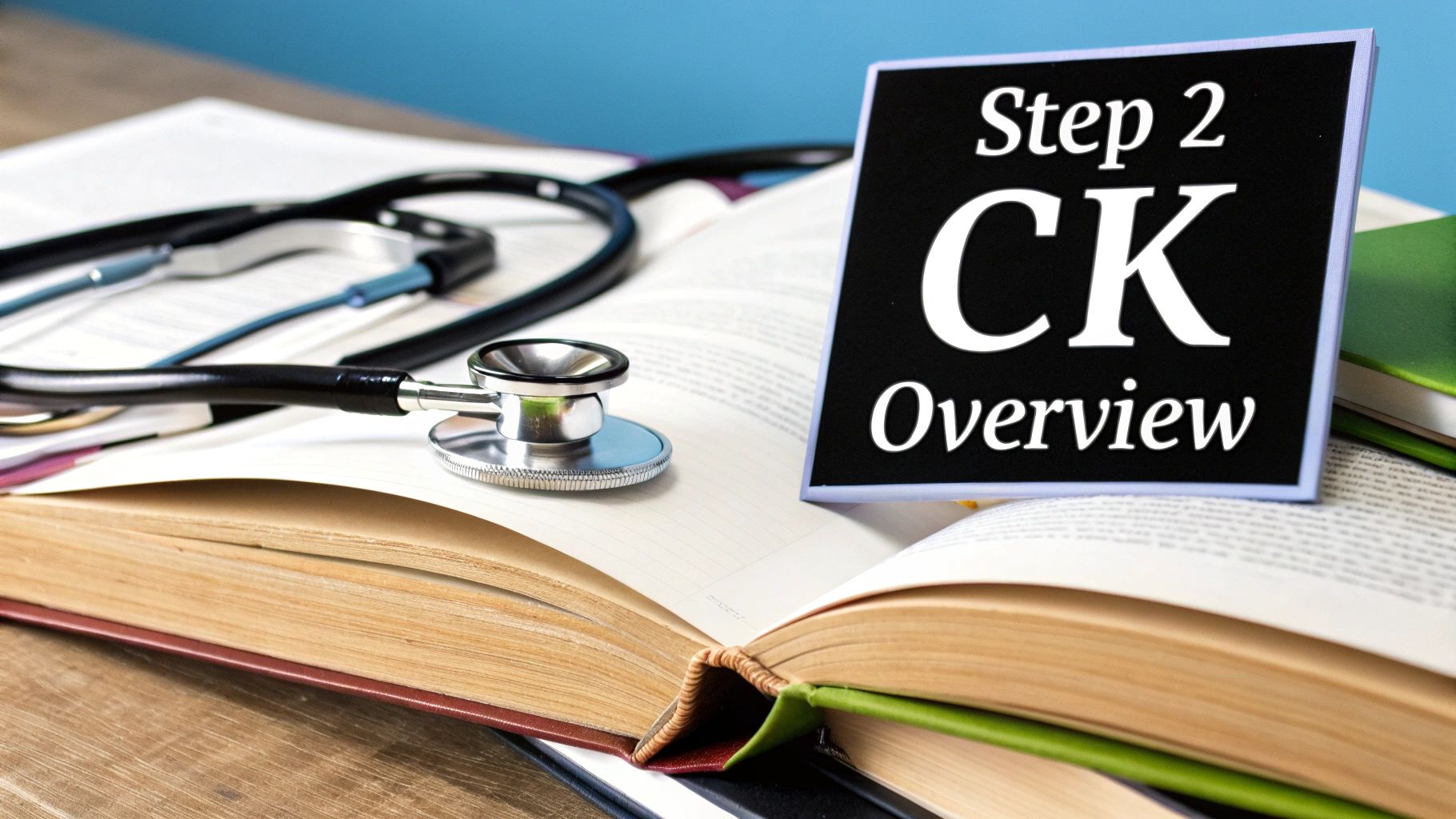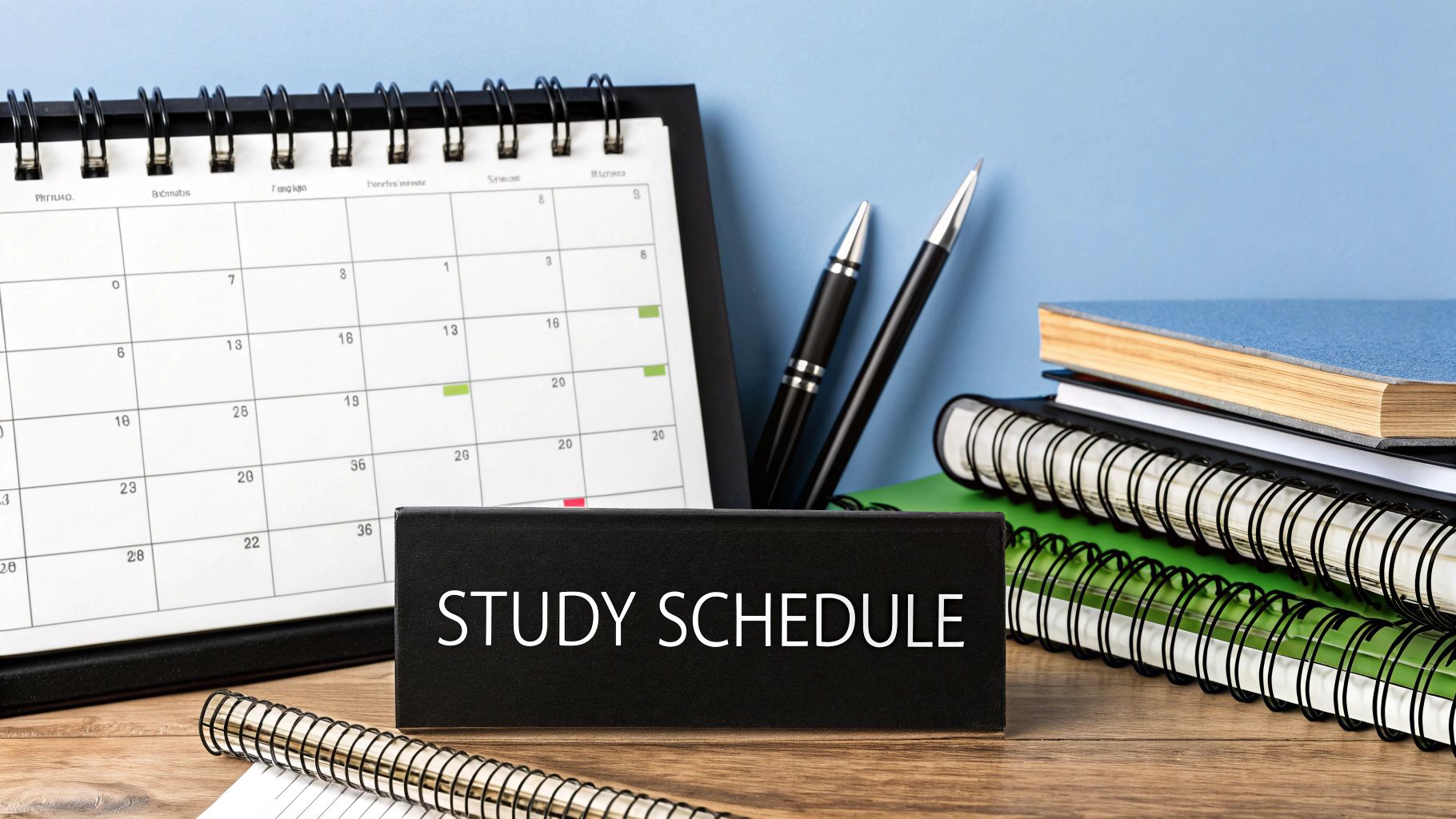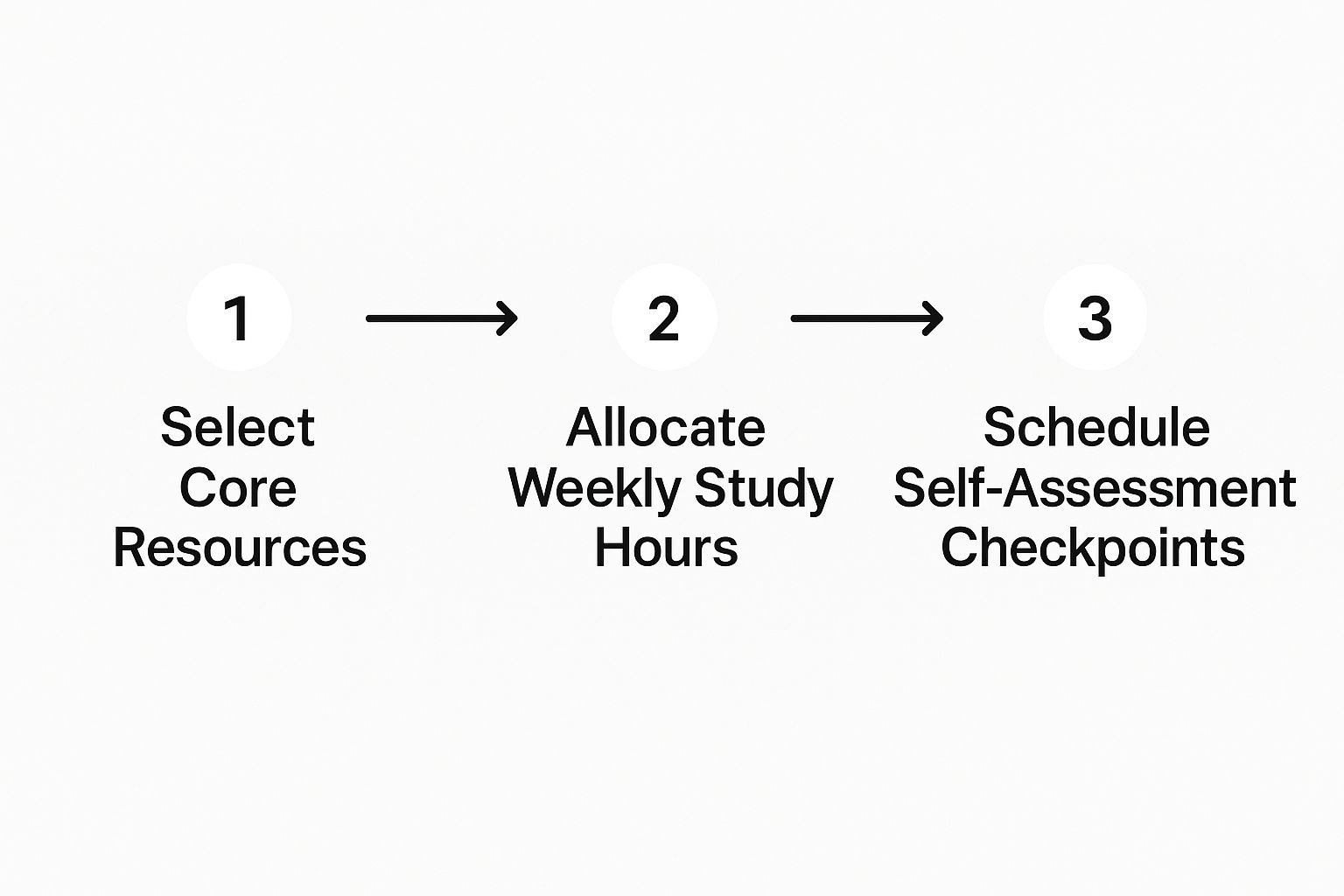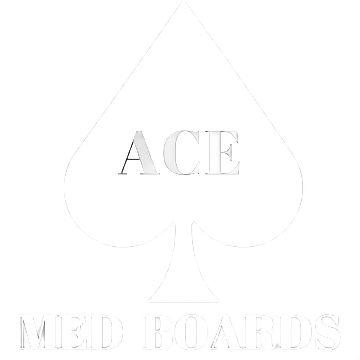A truly effective USMLE Step 2 CK study plan isn't something you can just download. It has to be built from the ground up, starting with a brutally honest look at your own clinical knowledge, where you want to go for residency, and how you actually study best. This is what separates a generic schedule from a strategic roadmap to success.
Building Your Personalized Study Foundation

Before you even think about hitting the UWorld Qbank or opening a single review book, the most critical work is internal. Now that Step 1 is pass/fail, your Step 2 CK score is the single most important academic number residency programs will see. That means your prep can't be random—it has to be intentional from the very beginning.
This initial phase is all about introspection and logistics. It’s where you lay the groundwork and adopt strategies to study smarter not harder. A solid foundation ensures every hour you invest is focused on what will actually move the needle on your score.
Conduct an Honest Self-Assessment
Your third-year clerkships were more than just a series of rotations; they were a diagnostic test of your clinical knowledge. Now it’s time to analyze the results. And you have to be completely honest with yourself. Don't just glance at your Shelf exam scores. Think back: which rotations felt like a breeze, and which ones were a daily struggle?
Ask yourself these tough questions:
- Which subjects felt the weakest? Was it trying to remember antibiotic ladders in surgery? Or was it staring blankly at ECGs in internal medicine?
- Where did I consistently drop points on Shelf exams? Go back and look for patterns. Was it always endocrine questions? Or maybe pediatrics?
- What clinical scenarios make my palms sweat? Get specific. Is it managing a patient in DKA or trying to diagnose a rare genetic syndrome?
The answers to these questions are pure gold. They tell you exactly where to focus. If OB/GYN was a nightmare, it needs a bigger slice of your study schedule. Ignoring your weaknesses is the fastest way to get a score that doesn't reflect your true potential.
Key Takeaway: A personalized plan is built on a clear-eyed view of your strengths and weaknesses. A generic plan treats all subjects the same, but your time is far too valuable for that. Target the areas that will give you the biggest point gains.
Set a Realistic Target Score
Sure, everyone dreams of a 270+, but your target score needs to be both ambitious and realistic. This number is what will determine the intensity and length of your dedicated study period.
Start by digging into the most recent NRMP match data to see the average Step 2 CK scores for the specialties you're considering.
From there, weigh these factors:
- Your Target Specialty's Competitiveness: A future dermatologist is aiming for a different score than a future pediatrician. Know the benchmark for your field.
- Your Overall Application: Got a ton of research or killer letters of recommendation? Your score might not need to be in the 99th percentile to be competitive.
- Your Starting Point: The first thing you should do is take an NBME self-assessment to get a baseline. Your goal should be a significant—but achievable—jump from that initial score.
Setting a concrete target, like aiming for a 255 for a competitive specialty when your baseline is 230, gives you a tangible goal to work toward. It turns the vague idea of "studying hard" into a focused mission. This number will be your north star, helping you track your progress with each subsequent practice exam.
Choosing Your High-Yield Resource Toolkit

Alright, you've done your self-assessment and know where you stand. Now for the fun part: building your arsenal of study resources. It's easy to get paralyzed by the sheer number of options out there, but trust me on this—the goal isn't to use everything. It’s to pick the right tools and use them strategically.
Quality always trumps quantity here. A focused toolkit will keep you from getting bogged down by resource overload and make sure your energy is spent on what actually moves the needle.
Let's start with the non-negotiable cornerstone of any successful Step 2 CK prep: the UWorld question bank. This isn’t just a resource; for all intents and purposes, it is your primary study tool. You'll be spending the vast majority of your time here, and for good reason. Its questions are meticulously crafted to match the style, length, and clinical reasoning you'll face on the real exam.
Mastering Your Core Resource: UWorld
Simply plowing through thousands of UWorld questions isn't the magic bullet. How you use it is what separates a passing score from a great one. You need a smart approach that balances its two main modes: tutor and timed. Each has a specific job in your prep.
Tutor Mode: This is your best friend when you're starting out or diving into a subject that makes you break out in a cold sweat. Answering a question and immediately seeing the explanation forges a direct link between the clinical puzzle and the core concepts. Use this mode for deep, foundational learning.
Timed Mode: As you get more comfortable, you have to start simulating the real deal. Doing blocks of 40 questions on the clock builds the mental stamina and pacing you absolutely need for a nine-hour exam. This mode is all about performance and execution under pressure.
A balanced approach works wonders. You might start a new system (like cardiology) in tutor mode to really nail down the basics, then switch to timed blocks to test your recall and speed. No matter which mode you're in, the real learning happens during your review. A good rule of thumb is to spend 2-3 times longer reviewing a block than it took you to complete it.
Pro Tip: Your main goal should be one complete, thoughtful pass of the entire UWorld Qbank. Focus on understanding the "why" behind every answer choice, both right and wrong. If you have time for a second pass, stick to your incorrect and marked questions—that's the highest-yield review you can possibly do.
Selecting Supplementary Learning Tools
While UWorld is the main event, a few carefully chosen supplementary tools can patch up knowledge gaps and make information stick for the long haul. Think of these not as replacements for your Qbank, but as powerful allies.
Anki for Spaced Repetition
Anki is your weapon against the forgetting curve. It’s perfect for creating flashcards for tricky concepts from UWorld, annoying drug side effects, or key diagnostic criteria you keep mixing up. You can find massive pre-made decks like AnKing, but honestly, the most powerful cards are the ones you make yourself, tailored to your unique weak spots.
Video Platforms for Conceptual Clarity
Let's be real: sometimes reading an explanation just doesn't cut it. When you're staring at a diagram of acid-base disorders for the tenth time and it still looks like gibberish, video platforms can be a lifesaver. Resources like OnlineMedEd or Boards and Beyond deliver clear, digestible videos that are perfect for breaking down those tough topics.
Integrating Practice Exams Strategically
Practice exams are your reality checks. They’re essential for tracking your progress, shining a spotlight on lingering weak areas, and getting you used to the grueling marathon that is test day. A solid plan will incorporate both NBME Self-Assessments and the UWorld Self-Assessments (UWSAs). For a more in-depth look at building a full study strategy, our guide on https://acemedboards.com/how-to-study-for-usmle-step-2/ offers some great additional insights.
Here’s a breakdown of the core resources and how to fit them into your schedule.
Core vs. Supplementary Step 2 CK Resource Comparison
This table outlines the essential and optional study resources, explaining what they're best for and when to use them in your study plan.
| Resource Type | Primary Use Case | When to Use |
|---|---|---|
| NBME Self-Assessments | Gauge foundational knowledge and identify weak organ systems. | Take one as a baseline, then every 1-2 weeks during your dedicated study period. |
| UWorld Self-Assessments (UWSAs) | Provide a predictive score range as you get closer to your exam. | Take UWSA 1 midway through dedicated, and UWSA 2 about 1 week before the real thing. |
| Free 120 | Familiarize yourself with the exact exam interface and question style. | Complete this 2-3 days before your test day to build confidence and calm your nerves. |
Don't just take these exams to see a score. The real gold is in the review. Block off an entire day after each practice test to meticulously go through every single question. Look for patterns in your mistakes. This data-driven approach is what allows you to fine-tune your USMLE Step 2 CK study plan on the fly, ensuring you’re always focusing your precious time where it counts the most.
Designing Your Dedicated Study Schedule
You’ve got your resources picked out. Now it's time to shift from the "what" to the "how." A solid, well-thought-out schedule is the engine that will drive your entire Step 2 CK prep. It’s what turns that overwhelming mountain of tasks into a manageable, day-by-day checklist. This is where you build a routine that balances intense focus with the recovery time you absolutely need to avoid burnout.
One of the first big decisions you'll face is how to structure your review. Do you organize it by organ system (like a "Cardiology week") or dive straight into random, timed blocks from day one? Honestly, there’s no single right answer, but each approach has its pros and cons.
This infographic gives you a great visual breakdown of how to build the framework for your schedule.

As you can see, it's a cyclical process. You pick your resources, allocate your time, test yourself with assessments, and then use that feedback to refine your plan.
System-Based vs. Random Question Blocks
Choosing your question block strategy is a foundational decision. A system-based review is fantastic for immersing yourself in one topic at a time. You might spend a few days laser-focused on pulmonology questions, videos, and flashcards, which is a great way to shore up any major weak spots you found in your baseline assessment.
On the other hand, random blocks are a much better simulation of the real exam. Step 2 CK is designed to be unpredictable, jumping from psychiatry to surgery to pediatrics without any warning. Practicing with random blocks is how you train your brain to make those rapid mental shifts.
Many high-scorers I've worked with use a hybrid approach. They start with system-based blocks for their weakest subjects and then switch entirely to random, timed blocks for most of their dedicated period.
A common pitfall is getting stuck in system-based review for too long. It feels productive, but it can create a false sense of security. Make sure you switch to mostly random blocks at least 3-4 weeks before your exam to get used to the real test-day conditions.
Crafting Your Ideal Study Day
So, what does a truly effective study day actually look like? It's not about chaining yourself to your desk for 14 hours straight. It's about structuring your time for maximum focus and retention. The best plans mix different study methods throughout the day.
Here’s a daily template that works well for many students:
- Morning (8 AM – 12 PM): This is usually your peak focus time. Hit your most demanding task first: two 40-question UWorld blocks, done in timed mode. After the blocks, do a meticulous review of the first one.
- Lunch Break (12 PM – 1 PM): Seriously, step away from your desk. Eat, take a walk, do something that lets your brain reset completely.
- Afternoon (1 PM – 5 PM): Dive back in and review that second UWorld block. This review process is where the real learning happens. Follow that with an hour of targeted content review—maybe watch a video on a confusing topic or knock out your daily Anki cards.
- Evening (After 5 PM): Time to wind down. Light exercise, hobbies, or just relaxing with family and friends are non-negotiable for long-term sustainability. Avoid intense studying right before bed; it will wreck your sleep quality.
This kind of structure gives you about 8 hours of active, high-yield learning while still protecting your personal time for recovery. For more ideas, you can check out different templates in our guide to crafting a personalized USMLE Step 2 CK study schedule.
Scheduling Your Self-Assessments
Think of practice exams as your progress checkpoints. They give you invaluable data on your performance and, just as importantly, help build the mental stamina you'll need for the nine-hour beast that is Step 2 CK. You should plan to take one full-length practice test per week, starting about 4-5 weeks out from your exam.
A typical self-assessment schedule could look like this:
- 4 Weeks Out: NBME Form 9 or 10
- 3 Weeks Out: NBME Form 11 or 12
- 2 Weeks Out: UWSA 1
- 1 Week Out: UWSA 2
- 3 Days Out: Free 120
Treat every single practice exam like the real deal. Start early, take timed breaks, and push through the fatigue. The day after each exam should be reserved only for reviewing every single question—right or wrong—to squeeze every last drop of learning out of it.
This level of rigorous planning is becoming more important. It's worth noting that the standards are always being re-evaluated. For instance, starting July 1, 2025, the USMLE Step 2 CK passing score will increase from 214 to 218. This shift just underscores the need for a deep, clinically-focused study plan to meet these evolving criteria. You can read more about this change on the official USMLE site.
Analyzing Your Performance Data to Adapt and Improve

Here's a hard truth: a static study plan is your enemy. The students who crush Step 2 CK don’t just follow a schedule—they actively shape it based on a constant stream of performance data. This loop of studying, assessing, and improving is what turns a good plan into a great one.
Think of yourself as a data scientist with a single, very important subject: you. Every UWorld block and every NBME practice test is a fresh data point. Your job is to connect these dots to find trends, pinpoint your weaknesses, and shift your focus where it will have the biggest impact.
Moving Beyond the Percent Correct
The most common trap students fall into is obsessing over the percent correct on a UWorld block. That number is just surface-level data. The real gold is buried in the methodical review of every single question, especially the ones you got wrong.
Your goal is to understand the "why" behind each answer. Why was the correct option better than the others? Just as importantly, why were the incorrect options definitively wrong? This depth of analysis transforms a simple Qbank from a testing tool into your most powerful diagnostic tool.
For instance, let's say you incorrectly chose "CT angiography" over "V/Q scan" for a suspected pulmonary embolism in a pregnant patient. Don't just memorize the right answer. Dig into the reasoning: the contraindication of radiation, the specific clinical context, and the scenarios where a CTA would have been the right call. This deep-dive approach prevents you from making the same clinical reasoning mistake down the road.
Turning Mistakes into Actionable Insights
Just reviewing your incorrects isn't enough. You need a system to turn those mistakes into concrete learning opportunities. Without a system, you’re just hoping you won’t make the same errors again on future practice tests.
Here are a few practical ways to systematize your error review:
- Targeted Flashcards: Make a specific Anki card for every single incorrect question. The front should be a simplified version of the question stem, and the back needs to explain the core concept you missed.
- Digital Notebook: Keep a running Google Doc or OneNote file organized by subject (e.g., Cardiology, GI). For each incorrect, jot down a one-sentence summary of the main learning point.
- Screenshot and Annotate: Take a screenshot of the UWorld explanation and use a simple tool to highlight the key sentence or diagram that finally made the concept click.
This process ensures every mistake becomes a building block for a stronger knowledge base. It’s an ongoing cycle: identify a weakness, address it with a targeted tool, and then re-test that knowledge later on.
How to Read Your NBME and UWSA Score Reports
Your practice exam score reports are a goldmine. Don't just glance at the three-digit score and move on. You need to dive into the performance breakdown by system and discipline to spot your weakest areas. Our guide on using NBME practice exams for Step 2 can help you get the most out of these assessments.
A classic scenario is seeing consistently low performance in "Endocrine, Diabetes, & Metabolism." This isn't just a number; it's a bright, flashing signal. For the next week, you should adjust your usmle step 2 ck study plan to dedicate extra time to this system. Maybe that means doing an extra block of UWorld endocrine questions or watching a couple of review videos on DKA and thyroid storm management.
This kind of data-driven adaptation is what separates passive studying from active, intelligent preparation.
And this level of focus is critical. In the 2023–2024 testing cycle, 98% of first-time MD examinees passed Step 2 CK. That sounds great, but the success rate for repeat examinees was much, much lower. This stat from the official USMLE data page highlights just how crucial a structured, adaptive plan is for getting it right the first time.
Specific Advice for International Medical Graduates
For International Medical Graduates (IMGs), the USMLE Step 2 CK isn't just another test. It’s a make-or-break moment on a much longer journey toward residency in the United States. The pressure hits differently, and the stakes feel incredibly high because this score is one of the main tools residency programs use to compare you with U.S. graduates.
Your usmle step 2 ck study plan absolutely must be built with this reality in mind.
The biggest hurdle for many IMGs is bridging the subtle (and sometimes not-so-subtle) differences in clinical training. Your medical school was likely excellent, but it might have prioritized different diagnostic pathways or treatment protocols than what’s standard in the U.S. Your study plan has to be laser-focused on mastering the specific nuances of U.S. clinical guidelines, ethics, and patient communication—all heavily tested areas.
Closing the Clinical Gaps
First things first: you need to do an honest, tough self-assessment to find where these gaps are. Don't just think about what subjects you're weak in. Go deeper. Think about clinical reasoning. For example, were the first-line treatments for hypertension or type 2 diabetes different where you trained? Did you use different diagnostic algorithms?
To get on track, your study plan needs to include:
- A deep dive into U.S. guidelines. Don't just skim them. Actively hunt down and study the latest recommendations from major players like the American Heart Association (AHA) and the U.S. Preventive Services Task Force (USPSTF).
- Serious focus on ethics and communication. The UWorld questions on these topics are pure gold. Your goal isn't just to get them right but to understand the core ethical principles and communication frameworks that drive the correct answers. This is a huge part of U.S. clinical culture.
This isn't about memorizing random facts. It's about fundamentally aligning your clinical mind with the expectations of the exam and, more importantly, your future residency program.
Let's be blunt: the data shows that IMG applicants generally need higher scores to be competitive. Your study plan needs to aim for mastery, not just a passing grade. You're trying to prove clinical excellence.
Know the Numbers You're Up Against
The need for a high score isn't just a rumor; it's written all over the match data. Average Step 2 CK scores vary quite a bit depending on who you are. For instance, among U.S. citizen IMGs who successfully matched, the average Step 2 CK score was 236. For non-U.S. citizen IMGs, that average jumped to 245.
These numbers tell a clear story. IMGs have to build a study schedule that targets a truly competitive score for their chosen specialty. You can learn more about how Step 2 scores impact match prospects on the AMA's website.
What does this mean for your timeline? It might need to be longer than you think. If your self-assessment uncovers big knowledge gaps, it is far better to push back your test date than to walk in unprepared. Build your plan around hitting a target score, not just sticking to a calendar. This strategic patience is what will ultimately forge a residency application that program directors can't ignore.
Common Step 2 CK Study Plan Questions
As you start putting all the pieces of your study plan together, a bunch of questions are bound to pop up. It's totally normal. Let's walk through some of the most common hurdles students face so you can stay on track and feel confident in your approach.
How Long Should My Dedicated Study Period Be?
This is probably the number one question I get, and the honest answer is: it depends entirely on you.
For most students, a 4 to 6-week dedicated period hits the sweet spot. A shorter, more intense 4-week grind can work great if you absolutely crushed your third-year clerkships and have a rock-solid clinical foundation. If your Shelf exam scores were strong, this might be all you need.
But what if you're gunning for a super competitive score? Or maybe your baseline assessment revealed some serious content gaps. If you're an IMG, you might also want extra time to close any clinical differences. In those cases, stretching your dedicated period to 6 or even 8 weeks is a smart move. That extra runway gives you time for a deeper review and multiple practice exams without hitting total burnout.
Key Takeaway: Don't just pick a number out of a hat. Your decision should be rooted in data. Look at your baseline NBME score, define your target score, and then honestly assess how much time you'll need to bridge that gap.
Should I Reset My UWorld Question Bank?
Ah, the classic UWorld reset dilemma. Whether or not you should hit that button comes down to one thing: how you used the Qbank during your clerkships.
You probably don't need to reset if you did a complete first pass, scored pretty well (think above 75%), and made detailed notes on every single question you got wrong. If that’s you, your time is much better spent zeroing in on your incorrect and marked questions. It’s a super-efficient way to target your personal weak spots.
On the other hand, a reset is a great idea if it's been months since your first pass, your initial score was on the lower side, or you just did questions sporadically without really digging into the explanations. Hitting reset gives you a clean slate. It lets you reinforce concepts from the ground up and get a much more accurate picture of your progress during dedicated.
How Many Practice Exams Are Truly Necessary?
You need enough practice exams to build up your test-day stamina and get reliable data, but not so many that you burn through valuable review time. The magic number for most people is at least 4 to 5 full-length practice exams.
A tried-and-true strategy is to take one every week in the final month of your prep. A solid mix would include:
- NBME Comprehensive Clinical Science Self-Assessments (CCSSAs): These are fantastic for tracking your progress and figuring out which systems are giving you trouble.
- UWorld Self-Assessments (UWSAs): These are known for giving you a predictive score range as you get closer to the real deal.
This rhythm does three things perfectly: it builds the endurance you need for the actual nine-hour exam, gives you the score data to see if you’re on track, and pinpoints any last-minute weaknesses for a final, laser-focused review.
What Is the Best Way to Spend My Final Week?
Let's be clear: the week before your exam is for consolidation and building confidence. It is not the time to cram new information. Your only job is to walk into that test center feeling rested and ready, not frazzled and exhausted.
You should drastically cut back on the number of new questions you're doing. Instead, that last week should be all about high-yield review activities:
- Skim through your notes on your weakest subjects.
- Go over the incorrects from your very last practice test one more time.
- Drill those pure memory items—vaccination schedules, cancer screening guidelines, and key formulas.
And the most critical piece of advice? Take the day before the exam completely off. I mean it. No studying. No questions. Your brain needs to be fresh for the marathon ahead. Go for a walk, watch a movie, and get a good night's sleep. Trust the work you've put in.
Feeling like you could use a hand putting these strategies into action? The expert tutors at Ace Med Boards live and breathe this stuff. We specialize in creating personalized study plans that actually get results. We can help you analyze your performance, target your weaknesses, and build a schedule that fits your life. Get started with a free consultation today.
